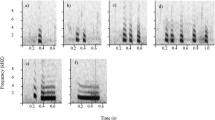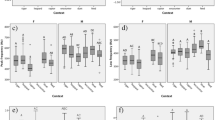Summary
-
1.
The purposes of this study were to assess the response eliciting properties of five structural variants of the California ground squirrel alarm call system, and to compare the responsiveness of females with and without young to the vocalizations. Tape recordings of alarm calls and control sounds were played back in the field to adult female ground squirrels. The squirrels responded very little to control sounds. Following alarm calls, however, posture height and running increased; feeding, walking and non-locomotion movements decreased. None of the playbacks elicited vocalizations from the squirrels.
-
2.
The four chatter-chat calls evoked patterns of response that were distinctly different from reactions to the whistle. The immediate running response to chatter-chats was followed quickly by upright posturing, which subsequently declined throughout the 3-min period following the call. Feeding was suppressed throughout the 3-min post-chatter-chat interval, but movement increased after initial inhibition. After the initial running response to whistles, walking was common and upright posturing was delayed until the second post-call minute. Feeding and nonlocomotion movement were initially suppressed but increased monotonically over time. We proposed that these differences were adaptively related to the fact that chatter-chats typically follow detection of terrestrial predators, whereas whistles usually signal flying raptors.
-
3.
The responses to the four chatter-chat calls were graded in intensity, reaching higher levels in response to calls with more notes and lower noise content. The chat, a one-note call with high noise content, evoked the weakest reaction. We proposed that these two dimensions of calling (number of notes and noise content), in conjunction with several other semi-independent parameters, provide a sufficient diversity of signals to permit specification of the referent of the call (conspecific or predator) as well as the arousal level of the caller.
-
4.
We hypothesized that kin selection was responsible for the greater responsiveness of parous than of nonparous females to the alarm calls, and we discussed some implications of this difference.
Similar content being viewed by others
References
Altmann, J.: Observational study of behavior: Sampling methods. Behaviour 49, 227–267 (1974)
Beer, C.G.: A view of birds. Minn. Symp. Child Psychol. 7, 47–86 (1973)
Betts, B.J.: Behavior in a population of Columbian ground squirrels, Spermophilus columbianus columbianus. Anim. Behav. 24. 652–680 (1976)
Brand, L.R.: The vocal repertoire of chipmunks (Genus Eutamias) in California. Anim. Behav. 24, 319–335 (1976)
Dunford, C.: Kin selection for ground squirrel alarm calls. Amer. Nat. 111, 782–785 (1977)
Kirk, R.E.: Experimental design: Procedures for the behavioral sciences. Belmont, California: Brooks/Cole 1968
Leger, D.W.: An empirical evaluation of instantaneous and one-zero sampling of chimpanzee behavior. Primates 18, 387–393 (1977)
Owings, D.H., Borchert, M., Virginia, R.: The behaviour of California ground squirrels. Anim. Behav. 28, 221–230 (1977)
Owings, D.H., Virginia, R.: Alarm calls of California ground squirrels. Z. Tierpsychol. (in press) (1978)
Sherman, P.W.: Nepotism and the evolution of alarm calls. Science 197, 1246–1253 (1977)
Wiley, R.H.: Communication and spatial relationship in a colony of common grackles. Anim. Behav. 24, 570–584 (1976)
Author information
Authors and Affiliations
Rights and permissions
About this article
Cite this article
Leger, D.W., Owings, D.H. Responses to alarm calls by California ground squirrels: Effects of call structure and maternal status. Behav Ecol Sociobiol 3, 177–186 (1978). https://doi.org/10.1007/BF00294989
Received:
Issue Date:
DOI: https://doi.org/10.1007/BF00294989




